Opened: January 12, 1909
Contractor: Dominion Bridge
Background:
In February 1906, the Municipality of Elmwood voted overwhelmingly to join the city of Winnipeg. They wanted in on services ranging from better fire protection to streetcars that their small, spread-out tax base could not afford.
The city wasted little time increasing access to its new suburb. In May 1906, the special bridge committee of Winnipeg city council recommended a new bridge to link the North End and Elmwood. The site chosen was east of the intersection of Main and Redwood.
Various subdivision ads from Autumn 1907
In June 1906, the city approached the respective landowners for the right-of-way to extend Redwood Avenue to the river and create a new street from the river to Birds Hill Road, now Henderson Highway.
The single land owner on the west side was E. L. Drewry whose Drewry's Brewery would sit just meters away from the new span. Negotiations dragged out until the bridge was almost complete, but an agreement was finally reached that allowed Redwood Avenue to cross his land as long as he wasn't charged tax on that portion of his frontage or for any increase in assessment due to having the new amenity next to his brewery.
On the east side of the river things were a little more complicated. The majority landowner William Hespeler agreed to give up the land as long as the smaller landowners in the area agreed, (and there were almost 40 of them !) These negotiations, too, took longer than expected but a right-of-way was eventually secured.
The Voice, April 5, 1907
The city had applied for permission and a federal engineer came to examine the plans, but his approval was still pending.
As it turned out, the feds did have a major problem with the city's plan. The bridge is made up three spans, the city designed the east and west spans to be 73 1/2 feet wide with a supporting pier underneath each one. Ottawa said that the placement of the piers that close together would interfere with ships trying to navigate the bend in the river. It insisted that they be placed 100 feet apart.
Tearing up the completed work and starting from scratch would cost the city a bundle. It was enough to send Mayor Ashdown to Ottawa to plead the city's case, (Sharpe was mayor in 1906 when the bridge work was approved.) Shortly after his return he got a letter from the federal Minister of Public Works that said, in part:
"Under these circumstances, I feel that my qualified permission to proceed with the construction of the bridge according to the present plan must be withdrawn, and that I must say at once that the plans must be changed to meet the judgment of the resident engineer and the department which concurs In his views.”
The city had no choice but to cease work and let a new contract for $29,461, also won by Kelly Brothers of Kenora, to remove two of the three piers and build new ones as per Ottawa's demands.Various city officials tried to blame each other but in the end no one person was held responsible.
The Voice, October 30, 1908
The dispute, which amounted to just over $1,100, eventually saw Kelly and the city battle it out in the courts. The ruling came in November 1908 that that the city could not compel a private contractor to pay a specific wage, even if it was carrying out city projects.

Manitoba Free Press, January 12, 1909
The contract for the superstructure of the bridge went to Dominion Bridge in summer 1908.
The man credited as the engineer for the project is H. C. Lott who was also responsible for Union Station and being in Toronto to supervise the planning of the St. Andrews Lock and Dam. In World War I, he enlisted with the Royal Engineers and did stints in France, Mesopotamia and Iraq, earning the Military Cross. He discharged to Montreal in 1919 and restarted his private career that took him to China and other international destinations.
The Redwood Bridge is made up of 700 tones of steel. It has three spans, two of 150 feet and one of 98 feet, and when the approaches are included measures 600 feet long. Dual streetcar tracks and related hardware were laid during construction and car service began a couple of months after it opened.
The superstructure's construction took place without any drama and was completed by the end of 1908. The bridge opened for traffic on January 12, 1909 which makes it Winnipeg's oldest existing bridge.
Similar swinging bridge at Kildonan Park
Where the crow's nest sat
To allow ships to pass through, the bridge's centre span swung open thanks to a large electric motor operated by a caretaker located in a crow's nest above the road surface, (similar to this, as seen at Kildonan Park.) In 1912, the second Louise Bridge was built with the same mechanism.
In some newspaper articles city officials claimed that it took just 5 minutes for the bridge to open but a 1955 Free Press editorial entitled "Slow Bridge" penned by "G.S.R." detailed the amount of time it actually took.
Earlier that month the city was contacted by Lockport's lock master to say that the Granite Rock was on its way to the city and required the Redwood to swing into action. By the 1950s such requests were a rarity and the engineering department had to gather together the workers required to disconnect the streetcar wires and water main that runs under the roadway. Then:
The unaccustomed wheels and cogs and hinges groaned and turned and flexed in their respective joints and sockets. The bridge, with only one false start, swung open and in less than 50 minutes the Granite Rock was on her way, leaving the experts to put the bridge together and straighten out the incidental traffic jam.
Winnipeg Free Press Weekly, July 23, 1989
By the 1970s the only local ships tall enough to need the Redwood and Louise bridges opened were the Paddlewheel Queen and M.S. Lord Selkirk II. The Paddlewheel removed its top two decks to allow it to go under them and the Lord Selkirk departed from the Redwood Docks which meant that it bypassed them altogether.
The last time the span opened to allow a ship through appears to be in 1978, though the city still did an annual test opening of the span. In 1989, the city discussed what to do with the swinging spans of the Redwood and Louise and in January 1990 applied to the federal government for permission to permanently close them.
An article in a January 1909 edition of The Voice said of the Redwood Bridge that "It has been built on a scale which it is felt will meet the needs of the district for the life of the bridge itself." I wonder if anyone imagined that over 100 years later it would still be serving Winnipeg and Elmwood as the city's oldest bridge?
Related:
Redwood Bridge Over Troubled Waters Winnipeg Free Press (My more detailed version of the history of the Redwood Bridge)
The Redwood Bridge's White Elephants West End Dumplings
Bridges City of Winnipeg Public Works





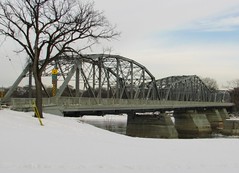
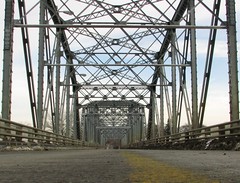
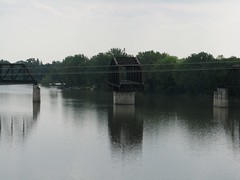
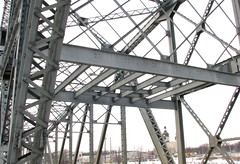

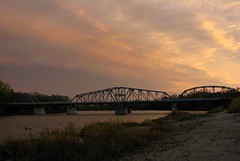
I miss the crow's nest (or the "little house" as I always thought of it). The Redwood bridge is such a great bridge and with the exception of rush hour it seems to carry just the perfect amount of traffic, well, at least on the W side of Redwood over Main St.
ReplyDeleteI was worried when it was closed in 2005/6 (I bought my house in 2006) that Redwood really was some sort of crazy major thoroughfare, but it's just a happy little extra bridge between the Disraeli and Chief Peguis :)